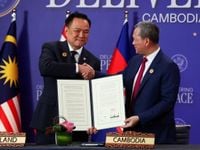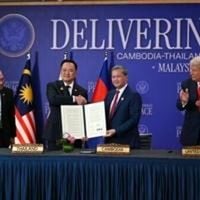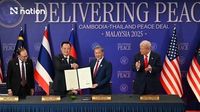In a moment charged with both hope and skepticism, Cambodian Prime Minister Hun Manet and Thai Prime Minister Anutin Charnvirakul signed a landmark peace declaration on October 26, 2025, aiming to resolve their countries’ decades-long border dispute. The signing, which took place on the sidelines of the 47th ASEAN Summit in Kuala Lumpur, was witnessed by U.S. President Donald Trump and Malaysian Prime Minister Anwar Ibrahim, the current chair of ASEAN. The so-called Kuala Lumpur Peace Accord builds on a fragile ceasefire brokered in July—one that ended five days of fierce border fighting, left more than 40 dead, and forced at least 300,000 people from their homes, according to Al Jazeera and Khaosod English.
Trump, who played a pivotal role in brokering the earlier ceasefire, did not hold back in his praise. “This is a momentous day for all of the people of Southeast Asia as we sign a historic agreement to end the military conflict between Cambodia and Thailand,” he declared after the ceremony, as reported by Khaosod English. Trump, ever the showman, recounted how he interrupted a golf game in Scotland to intervene in the crisis. “I said this is much more important than a round of golf. I could have had a lot of fun, but this is much more fun, … saving people and saving countries.”
The Kuala Lumpur Accord, as it’s now known, is the most detailed attempt yet to end the hostilities that have long plagued the Thai-Cambodian border. At its core, the agreement mandates the withdrawal of heavy weapons from contested areas, humanitarian landmine clearance, and enhanced cooperation to suppress online scamming operations—a nod to recent allegations of transnational crime in the region. An ASEAN Observer Team (AOT) will be established to monitor the ceasefire and verify military de-escalation, a move regional analysts see as a crucial test of ASEAN’s diplomatic muscle.
In a symbolic gesture meant to build trust, Thailand agreed to release 18 Cambodian soldiers it had detained during the July fighting. Both governments reaffirmed that existing bilateral mechanisms—the General Border Committee, Regional Border Committee, and Joint Boundary Commission—would remain the primary platforms for resolving border issues peacefully. They also pledged to replace missing border markers with temporary ones and to accelerate demarcation efforts in disputed areas, though the details remain vague.
The border dispute itself is steeped in history. The roughly 800-kilometer (nearly 500-mile) frontier is riddled with centuries-old temples and villages claimed by both sides, with demarcations dating back to a treaty signed in 1907 during French colonial rule. Tensions flared in February 2025 after Thai police reportedly stopped Cambodian tourists from singing their national anthem at the contested Prasat Ta Moan Thon temple. The situation escalated again in May, when the killing of a Cambodian soldier sparked a troop buildup and diplomatic crisis, culminating in the deadly July clashes.
Even after the ceasefire, the peace remained fragile. In August, Thai soldiers were injured by landmines while patrolling a buffer zone, prompting accusations from Bangkok that Cambodia had violated the ceasefire by laying new mines—an allegation Phnom Penh flatly denied. The new agreement’s provisions for coordinated de-mining and heavy weapon withdrawal are designed to address these flashpoints directly.
Reaction to the peace declaration has been mixed, reflecting deep-seated mistrust and political realities on both sides. In a Facebook livestream, Prime Minister Anutin sought to reassure Thai nationalists that the deal would not put Thailand at a disadvantage or involve the surrender of territory. “There is no indication that we will open checkpoints or take any action that suggests surrendering territory, such as ‘we will lose land,’” he said, adding, “Thais love peace, but will not shrink from war,” according to The Nation.
For his part, Hun Manet was keen to clarify that the deal would not entail any territorial losses for Cambodia. He described the declaration as a “historic day” and said it would “begin the process of mending our ties.” In a joint statement, both leaders reaffirmed their “unwavering commitment to peace and security between our two countries” and to restoring confidence and mutually beneficial relations.
Yet, as The Nation and Khaosod English have noted, nationalist sentiment remains a potent force. Thai nationalist ultras remain “suspicious of any deal with Cambodia, whom they regard as tricky if not dishonest,” wrote journalist Pravit Rojanaphruk. On the Cambodian side, Hun Manet’s government faces little formal opposition but cannot afford to appear weak amid persistent social media chatter accusing him of selling out national interests. The agreement’s language, which focuses on preparing conditions and codes of conduct rather than ceding territory, reflects these sensitivities.
Malaysian Prime Minister Anwar Ibrahim, who oversaw the signing, struck a hopeful note. “We are delighted to have you as colleagues, as true friends, and you understand the need to secure peace, to save our people, and also the ASEAN position as a region of peace and prosperity,” he said. Anwar also emphasized that “reconciliation is not concession but an act of courage.”
Trump’s involvement in the peace process was not limited to brokering a ceasefire. According to White House statements cited by Khaosod English, the U.S. president leveraged America’s status as the largest export market for both countries, threatening to withhold trade deals if the fighting continued. These tactics paid off: alongside the peace declaration, Trump announced reciprocal trade deals with Cambodia, Malaysia, and frameworks for negotiations with Thailand and Vietnam. The U.S. and Cambodia finalized a deal eliminating tariffs on U.S. goods, and the White House lifted an arms embargo imposed on Cambodia in 2021 over human rights concerns and alleged Chinese influence. Military cooperation is also set to resume, with plans to restart the bilateral Angkor Sentinel exercise and increase seats for Cambodian officers at U.S. military academies.
Despite the diplomatic fanfare, the situation on the ground remains tense. Land border crossings between Thailand and Cambodia are still closed, disrupting trade that totaled $10.45 billion last year. Allegations of “psychological warfare” have added a surreal twist: Cambodia’s former leader Hun Sen recently complained to the United Nations about “intense, high-pitched noises” being broadcast from Thailand across the border—sounds of wailing children, howling dogs, and ghostly apparitions, reportedly aimed at driving out Cambodian settlers. Thai social media activist Kannawat Pongpaibulwech, who orchestrated the nightly broadcasts with the blessing of the Thai army, told The Nation, “We just did it to protect our sovereignty.”
Whether the ceasefire and peace declaration will hold is an open question. Chheang Vannarith, a political analyst and chairman of Cambodia’s National Assembly Advisory Council, called the joint declaration “a positive, important step towards the restoration of peace and normalcy,” but warned that “the international community must keep closely monitoring the implementation.” Thitinan Pongsudhirak, a senior fellow at Chulalongkorn University, cautioned that both governments may be tempted to stoke nationalist sentiment for political gain, making the path to lasting peace a rocky one.
For now, the Kuala Lumpur Peace Accord stands as a testament to the power—and limits—of international diplomacy. The coming months will reveal whether the hard-won agreement can overcome the ghosts of history and the pressures of domestic politics, or whether Southeast Asia’s most stubborn border conflict will once again flare into crisis.






